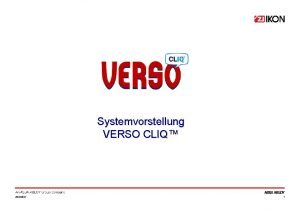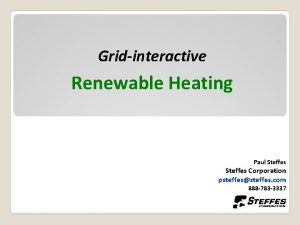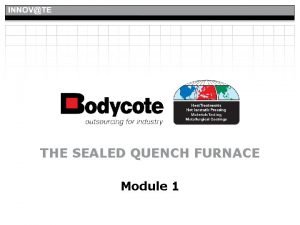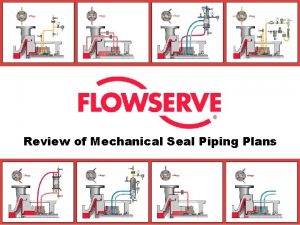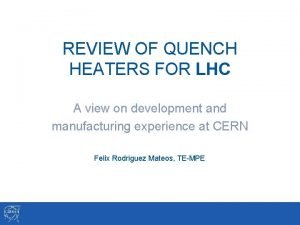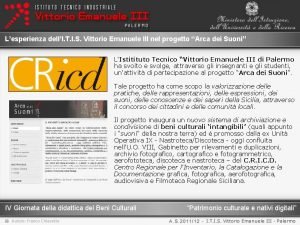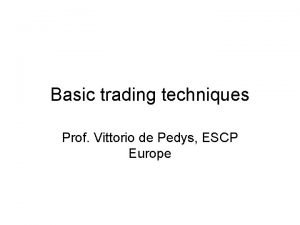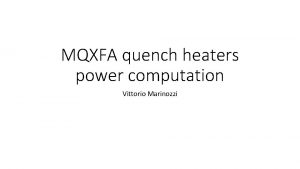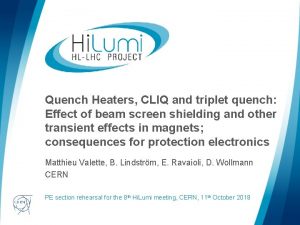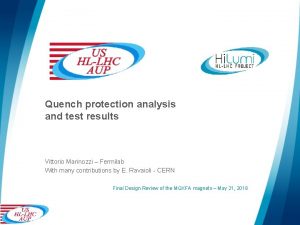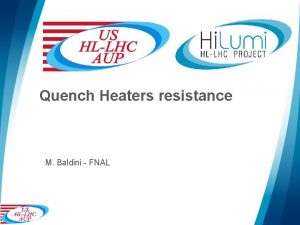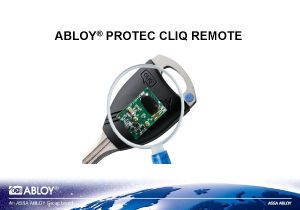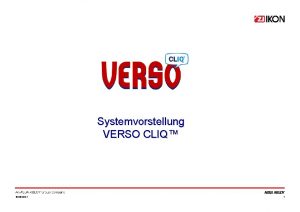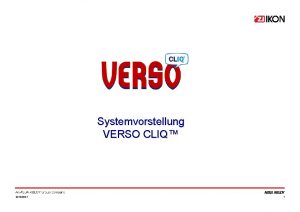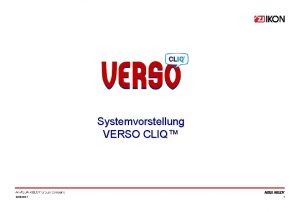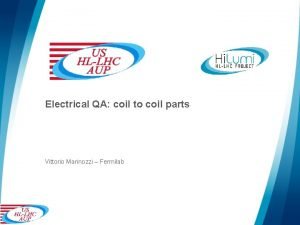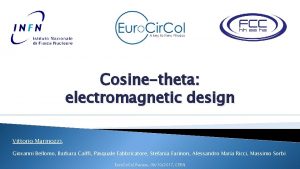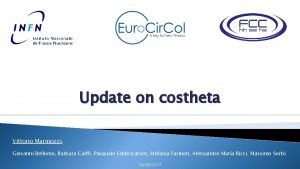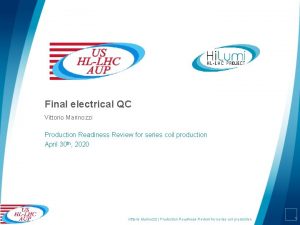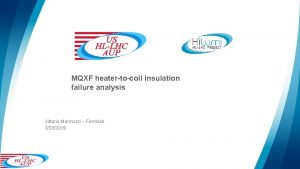Quench protection CLIQ and Quench heaters Vittorio Marinozzi


















- Slides: 18

Quench protection: CLIQ and Quench heaters Vittorio Marinozzi 2 nd International Magnet Test Stand Workshop 8 -9 May, 2018

Outline • • • 2 Quench protection of high-energy magnets Quench heaters: working mechanism CLIQ: working mechanism Quench heaters vs CLIQ Conclusions 10/24/20 20 Vittorio Marinozzi | 2 nd International Magnet Test Stand Workshop

Quench protection of high-energy magnets • During a quench, the electromagnetic energy stored into the magnet is dissipated into the normal zone (usually, small volume) • First approach: extract the energy • EE is limited by the voltage (~ 1 k. V) • For high-energy magnets, this method is generally not sufficient to ensure protection • Need of active methods: CLIQ and quench heaters Courtesy of E. Ravaioli 3 10/24/20 20 Vittorio Marinozzi | 2 nd International Magnet Test Stand Workshop

Quench protection of high-energy magnets • CLIQ and quench heaters are active methods to protect the magnet • Main goal: induce a quench in the largest volume as possible • Energy is not extracted, but it is dissipated inside the magnet • Average temperature is increased, but hot spot temperature is reduced 4 10/24/20 20 Vittorio Marinozzi | 2 nd International Magnet Test Stand Workshop

Quench Heaters: working mechanism • Quench heater is basically an RC circuit I ≈ 100 -500 A τ ≈ 100 ms R 1 S 1 Heater Firing Unit (HFU) S 2 Coil Magnet Test station V 0 C R 2 5 10/24/20 20 Vittorio Marinozzi | 2 nd International Magnet Test Stand Workshop

Quench Heaters: working mechanism 6 10/24/20 20 Vittorio Marinozzi | 2 nd International Magnet Test Stand Workshop

Quench Heaters: working mechanism • The quench heater efficiency depends on: – – – – HFU capacitance Voltage Number of HFUs Heater-coil insulation thickness Heater strips resistance Heater strips design and position Heater strips degradation Conductor properties • Combination of test stand availabilities and magnet design 7 10/24/20 20 Vittorio Marinozzi | 2 nd International Magnet Test Stand Workshop

Quench Heaters: working mechanism • Example: MQXFAP 1 at BNL • • • 8 10/24/20 20 24 heater strips 12 HFUs HFU voltage: 600 V (± 300 V) HFU capacitance : 12. 4 -14 m. F Heater strip resistance: 1. 7 -1. 1 Ω (10 K) Peak power density: 100 - 210 W/cm 2 Time constant: 50 -30 ms Insulation thickness: 50 µm Quenching time: 7 - 30 ms Vittorio Marinozzi | 2 nd International Magnet Test Stand Workshop

CLIQ: working mechanism • CLIQ: Coupling Loss Induced Quench • CLIQ exploits the coupling currents between filaments and strands, in order to induce a spread quench in the whole magnet • Main advantage: more effective heat deposition with more robust electrical circuit 9 10/24/20 20 Vittorio Marinozzi | 2 nd International Magnet Test Stand Workshop

CLIQ – Coupling-Loss Induced Quench system Courtesy of E. Ravaioli Patent EP 13174323. 9 Current change Magnetic field change Transitory losses (Heat) Temperature rise QUENCH 10 10/24/20 20 Vittorio Marinozzi | 2 nd International Magnet Test Stand Workshop

CLIQ: working mechanism I ≈ 1 -2 k. A τ ≈ 100 ms 11 10/24/20 20 Vittorio Marinozzi | 2 nd International Magnet Test Stand Workshop

CLIQ: working mechanism • The CLIQ efficiency depends on: – – – CLIQ capacitance CLIQ charging voltage Number of CLIQ units Number and position of the CLIQ connections on the magnet Magnet size Magnet geometry • Combination of test stand availabilities and magnet design 12 10/24/20 20 Vittorio Marinozzi | 2 nd International Magnet Test Stand Workshop

CLIQ: working mechanism CLIQ UNIT 13 10/24/20 20 LHC full size main dipole Vittorio Marinozzi | 2 nd International Magnet Test Stand Workshop

CLIQ: working mechanism • Example: commissioning at FNAL for MQXFS CLIQ unit Diodes to avoid reverse current in PS during CLIQ test 14 10/24/20 20 Vittorio Marinozzi | 2 nd International Magnet Test Stand Workshop

CLIQ: working mechanism Cliq has been successfully tested on several magnets: • MB (spare LHC main dipole) • MQY (spare LHC individually powered quadrupole) • MQXC • HQ 02 • MQXFS 1, MQXFS 3, MQXFS 5 • MQXFAP 1 • 11 T dipole • Small-scale solenoid • Small-scale HTS coil 15 10/24/20 20 Vittorio Marinozzi | 2 nd International Magnet Test Stand Workshop

CLIQ: working mechanism • Example: MQXFAP 1 at BNL – 1 CLIQ unit – CLIQ capacitance: 40 m. F – CLIQ charging voltage: 500 V – MIITs reduction respect to QH: ~15 % 16 10/24/20 20 Vittorio Marinozzi | 2 nd International Magnet Test Stand Workshop

CLIQ QUENCH HEATERS Quench Heaters vs CLIQ 17 § Simplementation in the test station § Quench heater circuit independent on the magnet circuit § Redundant § Independent on length § Damaged strips cannot be repaired § High voltage components very close to coils § Risk of shorts with coils § Bubbles when in contact with helium § More efficient to induce quench § Electrically robust § External to the magnet § Easy to repair § Slightly dependent on conductor properties § Need to implement parallel components in the test station § Implementation in the circuit not trivial (especially with EE) § 1 unit is fully not redundant § Effectiveness reduced with magnet length (short models do not fully demonstrate protection) 10/24/20 20 Vittorio Marinozzi | 2 nd International Magnet Test Stand Workshop

Conclusions • CLIQ and Quench Heaters are active protection systems, needed to protect high energy magnets • Quench Heaters implementation in a test station is relatively simple, but probability of electrical issues is larger • CLIQ is more robust and efficient, but the implementation in the test station circuit is not trivial • Just one CLIQ is not completely redundant, so it should be implemented together with a quench heaters system, or with other CLIQ units (complexity of circuit/connections) – “Third generation” CLIQ units will ensure redundancy of all internal components • Presence of HFUs in a test station today is mandatory to test large magnets. Adding a CLIQ unit ensures more efficiency and redundancy, and possibility to test more performing magnets in the future. 18 10/24/20 20 Vittorio Marinozzi | 2 nd International Magnet Test Stand Workshop
 Verso cliq
Verso cliq Joe bossert
Joe bossert Cliq designs
Cliq designs Academy heaters
Academy heaters Rheem solaraide price
Rheem solaraide price Paul steffes
Paul steffes Sealed quench furnace price
Sealed quench furnace price Many waters cannot quench love
Many waters cannot quench love Pump seal plan
Pump seal plan Lhc quench
Lhc quench Ital.regisseur vittorio 2 wörter
Ital.regisseur vittorio 2 wörter Active directory
Active directory Itis vittorio emanuele iii palermo
Itis vittorio emanuele iii palermo Ist vittorio emanuele bergamo
Ist vittorio emanuele bergamo Vittorio de pedys
Vittorio de pedys Vittorio reggianini biography
Vittorio reggianini biography Pio vittorio moroni
Pio vittorio moroni Pedys
Pedys Doctor vittorio zaffiri
Doctor vittorio zaffiri
